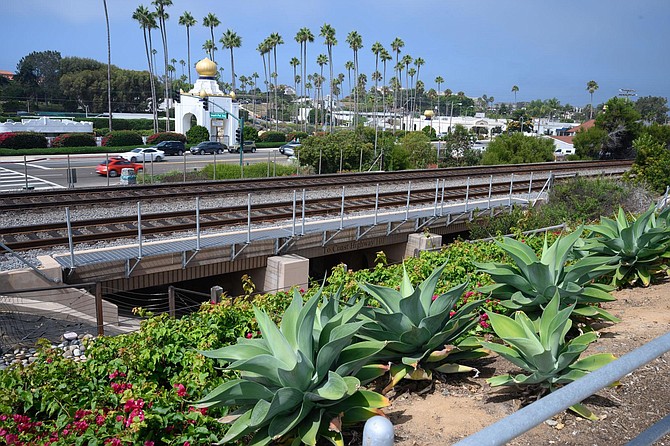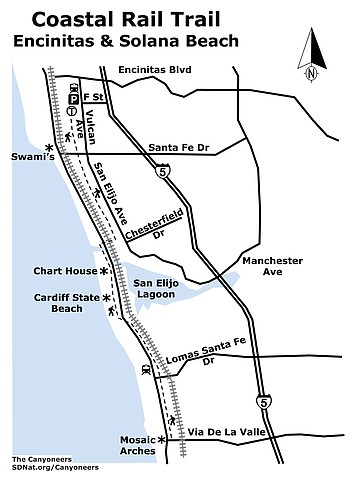 Facebook
Facebook
 X
X
 Instagram
Instagram
 TikTok
TikTok
 Youtube
Youtube

The San Diego Coastal Rail Trail is an ongoing project that will ultimately provide a way to navigate the 44 miles between downtown San Diego and Oceanside without a car. Ideally, this will be mostly a Class I bike trail, with access for walkers, hikers and recreational runners. Class I trails are physically separated from vehicular traffic by barriers or distance, making them safer, but they can be expensive to build. Most of the Coastal Rail Trail sections now in service are Class II: separate bike lanes on existing roads or highways, designated by signage and painted lines.
Encinitas recently completed construction of a 1.3-mile-long Class I segment of the Coastal Rail Trail that offers outstanding ocean views. Furthermore, a journey on this new trail can be combined with an exploration of the 1.7-mile Class I Solana Beach segment of the Coastal Rail Trail. Although the Solana Beach and Encinitas Class I segments do not directly connect, there is an excellent trail along the sand dunes at Cardiff State Beach that make this connection possible and very worthwhile.
Start your trip at the south end of the West Coaster parking lot. A well-trod dirt trail begins here and takes you to the northern end of the newly opened Encinitas Coastal Rail Trail. It is parallel to the railroad tracks but above and safely separated from them. This broad dirt trail goes through coastal sage scrub habitat with some large lemonadeberry bushes, lots of telegraph weed, along with a host of invasive, non-native plants, including black mustard, castor bean trees, star thistles, and sea-lavender.
On reaching the paved Encinitas Coastal Rail Trail, you will be faced with a choice. A short side trail leads to the Swami’s railroad tracks undercrossing and across the Coast Highway to the Self-Realization Fellowship; Swami’s Beach, a famous surfing spot; and Swami’s Seaside Park, a shaded, grassy ocean overlook.
If you are saving these gems for a future visit, continue down the Coastal Rail Trail. On a day with good visibility, you will have a stunning panoramic ocean view as you head south. And once you enter the Cardiff section of the trail, you will encounter an older section with some interesting art works.
The Encinitas section of the Coastal Rail Trail ends at Chesterfield Drive. For the rest of this adventure, cross Hwy 101 at Chesterfield and proceed south on the walkway beside the highway. In about 0.05 mile, you will cross a bridge over the San Elijo Lagoon ocean outlet. Continuing on, you pass a trio of large restaurants between the trail and the ocean, but after the Chart House, only sand dunes lie between the walking path and the surf.
The section along the sand dunes at Cardiff State Beach is the best part of the hike from a natural history standpoint. Many waterfowl and shorebirds migrate through the county and may be spotted on the beaches and wetlands.
Some of the dunes have been here for many years and are covered with native dune vegetation, including coast locoweed, coast woolly-heads, prostrate lotus and sand verbena. The dunes were recently rebuilt using sand from the San Elijo Lagoon restoration project to provide an environment for endangered species, especially the snowy plover and the least tern, both of which nest in undisturbed sand. Another reason the sand dunes are important is that they protect the coast highway and the lagoon from winter storms.
On reaching the south end of Cardiff State Beach, carefully cross the coast highway and find the northern end of the Solana Beach Coastal Rail Trail. The trail was conceived in the early years of this century as part of a large project to lower the railroad tracks through the city and rebuild the Coaster Rail Station. It was designed by the Schmidt Design Group to be a linear park as well as a transportation corridor, and it features creative ceramic works by the artist Betsy Schultz as well as a variety of horticultural plants.
While it is a delightful place for a leisurely walk or bicycle ride, there is little native vegetation here to see, other than Torrey pines, a few toyons and Mojave yuccas. There is, however, an abundance of common horticultural shrubs and trees, including the dragon’s blood tree, Baja fairy duster, fox tail agave, and lantana. At the northern end of the Coastal Rail Trail, a new development is taking place called the Harbaugh Seaside Trails. It promises to provide a habitat for native plants as well as connections to other trails.
If you are planning on ending your trip at the Solana Beach Coaster Station, be sure to first complete the walk to Via De La Valle to see Betsy Schultz’s mosaic arches that illustrate highlights of Solana Beach’s history. It’s only a short distance south of the train station, and you wouldn’t want to miss it.

COASTAL RAIL TRAIL: ENCINITAS & SOLANA BEACH
Walk through and along three city beaches on this promising hike.


The San Diego Coastal Rail Trail is an ongoing project that will ultimately provide a way to navigate the 44 miles between downtown San Diego and Oceanside without a car. Ideally, this will be mostly a Class I bike trail, with access for walkers, hikers and recreational runners. Class I trails are physically separated from vehicular traffic by barriers or distance, making them safer, but they can be expensive to build. Most of the Coastal Rail Trail sections now in service are Class II: separate bike lanes on existing roads or highways, designated by signage and painted lines.
Encinitas recently completed construction of a 1.3-mile-long Class I segment of the Coastal Rail Trail that offers outstanding ocean views. Furthermore, a journey on this new trail can be combined with an exploration of the 1.7-mile Class I Solana Beach segment of the Coastal Rail Trail. Although the Solana Beach and Encinitas Class I segments do not directly connect, there is an excellent trail along the sand dunes at Cardiff State Beach that make this connection possible and very worthwhile.
Start your trip at the south end of the West Coaster parking lot. A well-trod dirt trail begins here and takes you to the northern end of the newly opened Encinitas Coastal Rail Trail. It is parallel to the railroad tracks but above and safely separated from them. This broad dirt trail goes through coastal sage scrub habitat with some large lemonadeberry bushes, lots of telegraph weed, along with a host of invasive, non-native plants, including black mustard, castor bean trees, star thistles, and sea-lavender.
On reaching the paved Encinitas Coastal Rail Trail, you will be faced with a choice. A short side trail leads to the Swami’s railroad tracks undercrossing and across the Coast Highway to the Self-Realization Fellowship; Swami’s Beach, a famous surfing spot; and Swami’s Seaside Park, a shaded, grassy ocean overlook.
If you are saving these gems for a future visit, continue down the Coastal Rail Trail. On a day with good visibility, you will have a stunning panoramic ocean view as you head south. And once you enter the Cardiff section of the trail, you will encounter an older section with some interesting art works.
The Encinitas section of the Coastal Rail Trail ends at Chesterfield Drive. For the rest of this adventure, cross Hwy 101 at Chesterfield and proceed south on the walkway beside the highway. In about 0.05 mile, you will cross a bridge over the San Elijo Lagoon ocean outlet. Continuing on, you pass a trio of large restaurants between the trail and the ocean, but after the Chart House, only sand dunes lie between the walking path and the surf.
The section along the sand dunes at Cardiff State Beach is the best part of the hike from a natural history standpoint. Many waterfowl and shorebirds migrate through the county and may be spotted on the beaches and wetlands.
Some of the dunes have been here for many years and are covered with native dune vegetation, including coast locoweed, coast woolly-heads, prostrate lotus and sand verbena. The dunes were recently rebuilt using sand from the San Elijo Lagoon restoration project to provide an environment for endangered species, especially the snowy plover and the least tern, both of which nest in undisturbed sand. Another reason the sand dunes are important is that they protect the coast highway and the lagoon from winter storms.
On reaching the south end of Cardiff State Beach, carefully cross the coast highway and find the northern end of the Solana Beach Coastal Rail Trail. The trail was conceived in the early years of this century as part of a large project to lower the railroad tracks through the city and rebuild the Coaster Rail Station. It was designed by the Schmidt Design Group to be a linear park as well as a transportation corridor, and it features creative ceramic works by the artist Betsy Schultz as well as a variety of horticultural plants.
While it is a delightful place for a leisurely walk or bicycle ride, there is little native vegetation here to see, other than Torrey pines, a few toyons and Mojave yuccas. There is, however, an abundance of common horticultural shrubs and trees, including the dragon’s blood tree, Baja fairy duster, fox tail agave, and lantana. At the northern end of the Coastal Rail Trail, a new development is taking place called the Harbaugh Seaside Trails. It promises to provide a habitat for native plants as well as connections to other trails.
If you are planning on ending your trip at the Solana Beach Coaster Station, be sure to first complete the walk to Via De La Valle to see Betsy Schultz’s mosaic arches that illustrate highlights of Solana Beach’s history. It’s only a short distance south of the train station, and you wouldn’t want to miss it.

COASTAL RAIL TRAIL: ENCINITAS & SOLANA BEACH
Walk through and along three city beaches on this promising hike.